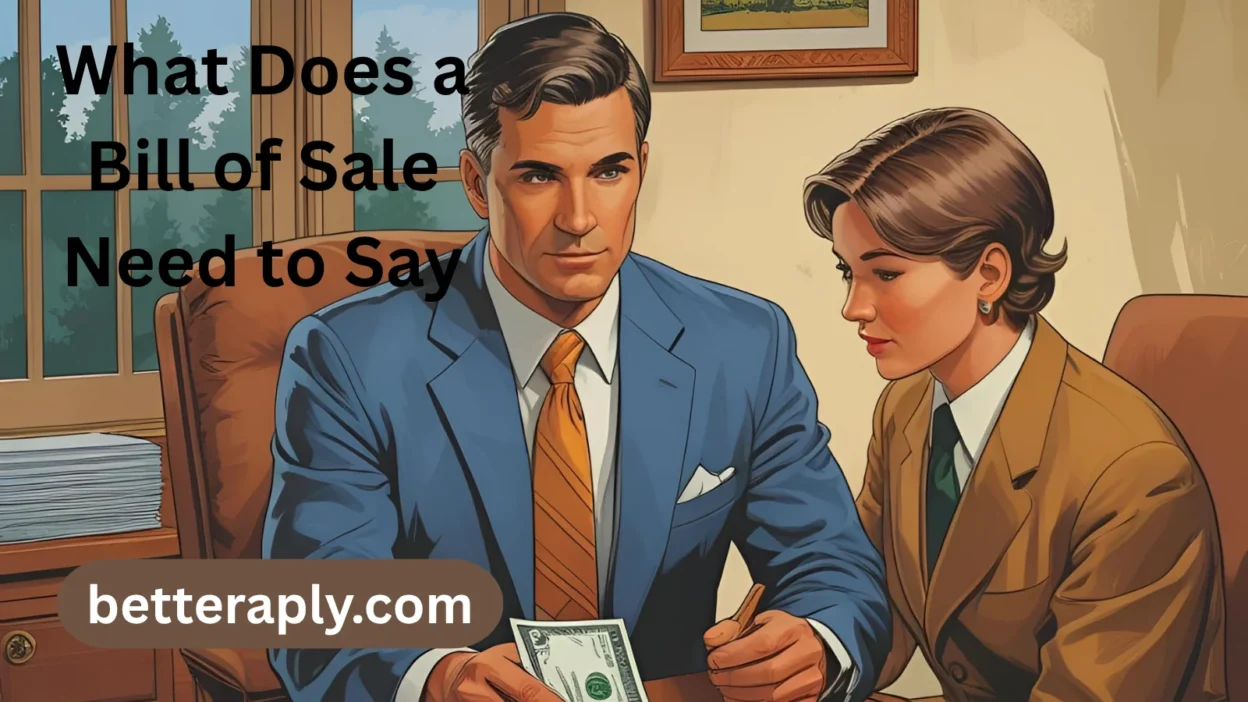Selling something big—like a car, boat, or even a trailer—can be exciting. But before you shake hands and hand over the keys, there’s one important document you can’t forget: the bill of sale. It’s not just a piece of paper—it’s your proof that a legal transfer happened.
So, what does a bill of sale need to say? If it’s missing key information, it could cause confusion or even legal trouble down the road. Whether you’re the buyer or seller, knowing what to include can protect both sides and help you sleep better at night.
This guide walks you through what a bill of sale should say, with real-life examples, clear checklists, and phrases to avoid. Let’s make sure your sale is safe, smart, and legally sound.
Sorry Generator
Start With Basic Information From Both Parties
Every good bill of sale starts with the buyer’s and seller’s full names and addresses. Without this, there’s no way to prove who was involved.
What to include:
- Full legal name of both buyer and seller
- Street address, city, state, and ZIP code
- Date the sale took place
🧾 Real-life example:
“Seller: John R. Davis, 123 Oak Street, Springfield, IL 62701
Buyer: Maria Lopez, 456 Pine Avenue, Springfield, IL 62704
Date of Sale: March 10, 2025”
What NOT to write:
- Just a first name or nickname
- No address or contact info
- A vague date like “sometime last week”
Being clear about who’s involved protects everyone if questions come up later.
Describe the Item Being Sold
Next, you’ll want to clearly describe what’s being sold. The more detail, the better—especially if there’s a disagreement later.
What to include:
- Make, model, year (for vehicles or electronics)
- Serial number or VIN (Vehicle Identification Number)
- Color, size, or condition
🛻 Example:
“2015 Toyota Corolla, VIN: 1NXBU4EE1AZ123456, silver, 98,000 miles, good condition”
What NOT to say:
- “Used car” without any other details
- “Old laptop” (not enough info)
- “As-is item” with no item listed
💡 If you’re selling something like a trailer, ATV, or collectible, include the item’s ID, model name, or registration number.
Add the Sale Price and Payment Terms
This part is simple but important: how much was the item sold for? And how was it paid?
What to include:
- Total price in dollars
- How the payment was made (cash, check, PayPal, etc.)
- Whether payment was made in full or on a schedule
💵 Example:
“Sale Price: $3,500 paid in full by cashier’s check on 3/10/2025”
What NOT to say:
- “Paid a fair price” (too vague)
- “Paid later” without dates or terms
- No amount listed at all
📝 If the buyer is paying in installments, list the schedule and due dates.
Include a Statement of Ownership and Condition
This section makes it clear that the seller has the right to sell the item and is being honest about its condition.
What to include:
- A line saying the seller owns the item legally
- A basic description of the condition (e.g., “sold as-is”)
- Optional: a note about warranties (if any)
🔒 Example:
“I certify that I am the legal owner of the vehicle listed above and it is being sold as-is with no warranties expressed or implied.”
What NOT to say:
- “Take it or leave it”
- “No idea if it works”
- Leaving out the ownership info entirely
✅ This part is especially important if the buyer plans to register the item with the state.
Signatures Make It Official
No bill of sale is valid without signatures from both the buyer and seller. It shows that both people agree to the terms.
What to include:
- Printed and signed names of both parties
- The date of signing
- Optional: a witness or notary if required by your state
🖊️ Example:
Seller Signature: ____________________ John R. Davis (3/10/2025)
Buyer Signature: ____________________ Maria Lopez (3/10/2025)
What NOT to say:
- “They agreed to it over the phone”
- “I didn’t get their signature”
- Using only initials
📌 Pro tip: Always keep a copy for both the buyer and seller.
Consider Adding Extra Notes or Disclosures
Sometimes it’s helpful to include extra information—especially for high-value items or special agreements.
Optional things to include:
- Odometer reading (for cars)
- Delivery details
- Special agreements (e.g., seller will hold the item for 7 days)
🚗 Example:
“Odometer reading at time of sale: 98,000 miles”
“Buyer agrees to pick up the vehicle by March 17, 2025”
What NOT to say:
- “Figure it out later”
- “We talked about that but didn’t write it down”
- Any unclear or missing side agreements
📘 A well-documented sale helps prevent future arguments.
Final Thoughts:
So, what does a bill of sale need to say? At minimum, it should include:
✅ Full names and addresses
✅ A clear item description
✅ The sale price and payment method
✅ Ownership and condition details
✅ Signatures from both sides
Adding a few extra notes can help, too. Whether you’re selling a car, laptop, or lawn mower, a good bill of sale protects both buyer and seller—and gives peace of mind. Take the time to write it right!




